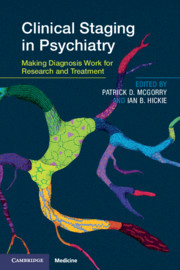Book contents
- Clinical Staging in Psychiatry
- Clinical Staging in Psychiatry
- Copyright page
- Contents
- Contributors
- Foreword
- Acknowledgements
- Section 1 Conceptual and Strategic Issues
- Section 2 Progress with Clinical Staging
- Section 3 Novel Treatment Strategies
- Section 4 Novel Treatment Strategies
- Chapter 13 Transforming Cultures to Enable Stage-Related Care of Mental Ill-Health
- Chapter 14 The Quest for Clinical Utility and Construct Validity in Psychiatric Diagnosis
- Index
- Plate Section (PDF Only)
- References
Chapter 14 - The Quest for Clinical Utility and Construct Validity in Psychiatric Diagnosis
from Section 4 - Novel Treatment Strategies
Published online by Cambridge University Press: 08 August 2019
- Clinical Staging in Psychiatry
- Clinical Staging in Psychiatry
- Copyright page
- Contents
- Contributors
- Foreword
- Acknowledgements
- Section 1 Conceptual and Strategic Issues
- Section 2 Progress with Clinical Staging
- Section 3 Novel Treatment Strategies
- Section 4 Novel Treatment Strategies
- Chapter 13 Transforming Cultures to Enable Stage-Related Care of Mental Ill-Health
- Chapter 14 The Quest for Clinical Utility and Construct Validity in Psychiatric Diagnosis
- Index
- Plate Section (PDF Only)
- References
Summary
Diagnosis plays a critical role in guiding treatment selection and predicting potential outcomes or the illness course. Traditional psychiatric diagnostic systems have largely failed to facilitate this. Clinical staging in psychiatry has emerged as a potential solution and offers the benefit of linking stage of illness to interventions that are proportional to both current need and the risk of progression. However, the model remains largely heuristic and is not yet fit for purpose in the clinical realm. In this concluding chapter, future directions to evolve and enhance clinical staging as a practical framework are proposed. At a fundamental level, there remain questions as to whether staging can span the full range of mental ill health and onsets across the lifespan. Efforts to create an international consensus model for transdiagnostic clinical staging are underway. Such a consensus could facilitate a coordinated global approach to research and may assist in resolving outstanding questions. To strengthen clinical staging, future research should involve a range of research methodologies and designs, including ecological momentary assessment, machine learning, and sequential clinical trials, which involve transdiagnostic cohorts of patients. In particular, research that integrates clinical staging and dynamic prediction approaches, such as network analysis and joint modelling, can contribute to refining the prediction of onset and course of mental illness and better guide intervention. Ultimately, the true value of clinical staging will be realised if it becomes a fundamental pillar of the diagnostic approach in mental health and becomes a pathway to superior treatment options that are more personalised and preventive in nature.
- Type
- Chapter
- Information
- Clinical Staging in PsychiatryMaking Diagnosis Work for Research and Treatment, pp. 278 - 283Publisher: Cambridge University PressPrint publication year: 2019



